When exploring how much to add an addition to your house, homeowners must consider various factors that influence both the cost and the overall success of the project.
Adding an addition to your home is not just about gaining extra space—it’s an investment into enhancing your lifestyle and increasing your property’s value. Particularly for homeowners who love their current neighborhood and wish to avoid the hassle of moving, additions provide a flexible solution to space needs, adapting your home to fit changing family dynamics or lifestyle aspirations. The desire for more space is a common motivator for homeowners considering an addition, as it offers a practical solution to the need for additional living areas without the need to relocate.
How Much to Add an Addition to a House
Home additions vary widely in scope and scale, from small bump-outs to full-scale multi-room expansions. Depending on your goals and existing property layout, an addition can cost anywhere from $50,000 to over $250,000.
A well-planned home addition can dramatically improve your living environment, offering a cost-effective alternative to moving and the opportunity to customize your living space to your exact needs. Whether it’s expanding your kitchen, adding a new bathroom, or extending the living room area, every addition is a chance to enhance both the functionality and aesthetic appeal of your home.
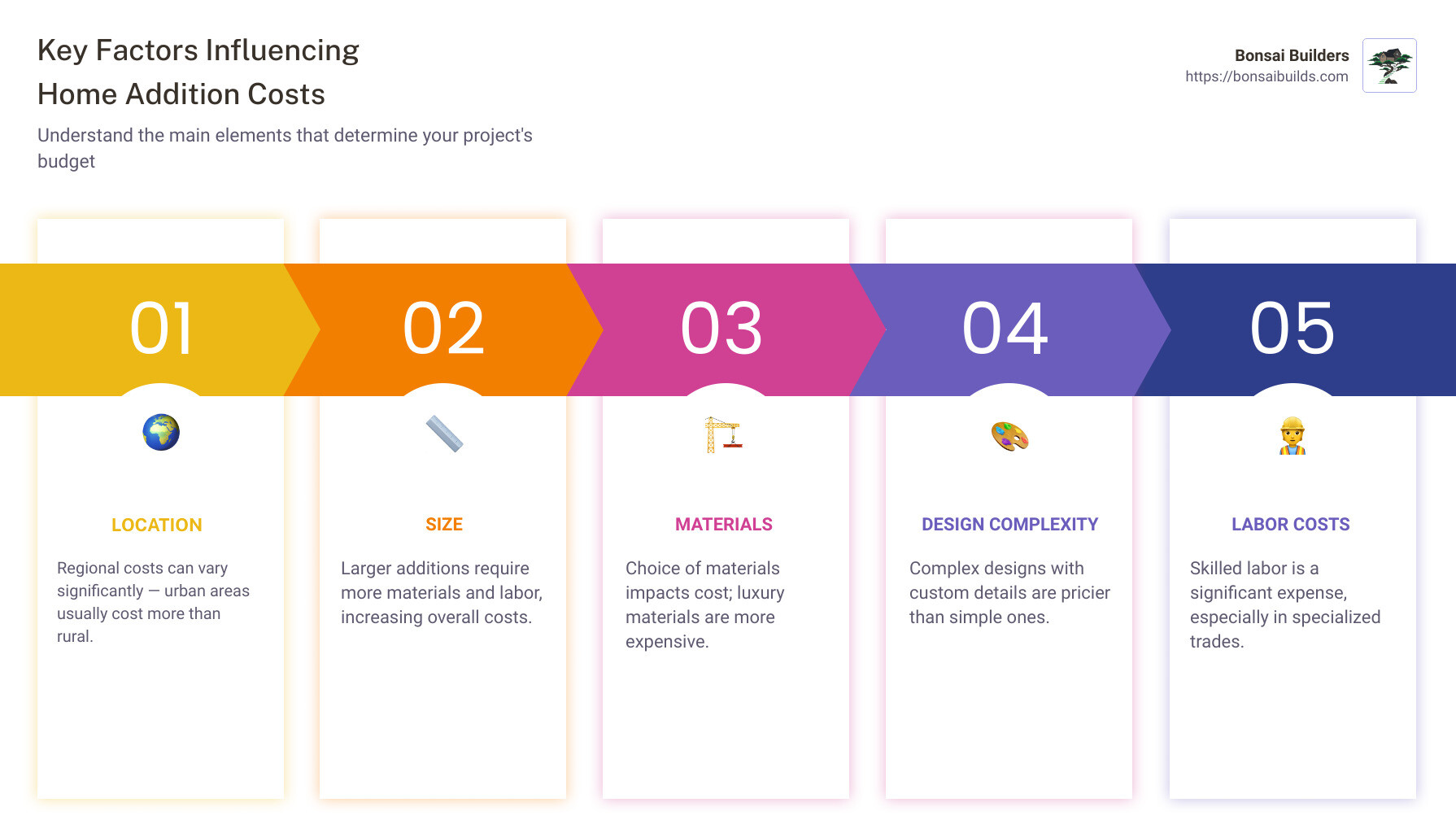
Table of Contents
Understanding the Costs of Home Additions
How Much to Add an Addition to a House
When considering how much to add an addition to a house, it’s important to note that a home addition typically ranges from $18,000 to $81,000, although costs can vary widely based on several factors including size, which can range anywhere from 250 to 1,200 square feet. On average, homeowners might spend up to $125,000 or more, depending on the type and scale of the addition.
Average Costs
The cost of home additions breaks down into several categories, including materials, labor, design, and any fees associated with permits and legal requirements. Here’s a general breakdown:
- Home office addition: $18,000 – $35,000
- Master bedroom: $25,000 – $100,000
- Bathroom: $20,000 – $60,000
- Kitchen: Around $65,000, can go up to $125,000 for luxury finishes
- Second story: $100 – $500 per square foot
Price Range
The price range can vary significantly based on the choice of materials, the existing structure, and the complexity of the addition. Material costs, for instance, can range from:
- Concrete: $4-$8 per square foot
- Steel beams: $100-$400 per foot
- Framing: $4-$16 per square foot
Cost Per Square Foot
Adding a second story typically costs between $100 and $500 per square foot. This higher range is due to the complexity of building upward, which often involves reinforcing the existing structure and possibly replacing the roof.
Factors Influencing the Cost of an Addition
Several factors can influence the cost of building an addition to your house: It’s also essential to consider how local building codes impact the planning and cost of home additions, as they dictate safety and structural requirements that vary for different types of additions.
Location
Costs can vary dramatically depending on where you live. Labor and material costs in urban areas like Los Angeles might be significantly higher compared to more rural areas.
Size
The larger the addition, the higher the cost. More square footage requires more materials, more labor, and potentially more complex design solutions.
Materials
The choice of materials has a substantial impact on the overall cost. High-end materials like natural stone countertops or hardwood flooring are more expensive than synthetic alternatives.
Design Complexity
Complex designs that require architectural input or custom-built features like large windows or specialized roofing can add to the cost. For instance, integrating a kitchen with high-end appliances and custom cabinetry will be more costly than a more straightforward bedroom addition.
Budgeting and Managing Costs
Proper budgeting is crucial for managing the costs of home additions and finding strategies to save money. It’s recommended to:
- Get multiple quotes: Always get estimates from at least five different contractors to compare prices and services. This is a straightforward way to save money by ensuring you’re not overpaying for the work to be done.
- Plan for extras: Include a buffer of 10-20% in your budget for unexpected expenses. This can help you save money in the long run by avoiding the need for additional financing or last-minute, high-cost solutions.
- Choose materials wisely: Opt for materials that offer a good balance between cost and quality. Sometimes, less expensive materials can offer durability and aesthetic appeal without the high price tag, which is another effective way to save money on your home addition project.
Labor Costs
Labor, including contractor labor costs, can account for about 30 to 50 percent of the total project cost, making it a significant portion of your budget. The expertise of the professionals involved—from architects and engineers to construction workers—can also influence the cost. Specialized skills may command higher fees, but they can provide better quality work and potentially reduce mistakes that lead to costly corrections. It’s advisable to obtain quotes from multiple general contractors to effectively manage these costs.
Understanding these factors can help you plan and execute your home addition project more effectively, ensuring that you can manage costs while achieving the desired outcome for your home.
Types of Home Additions and Their Costs
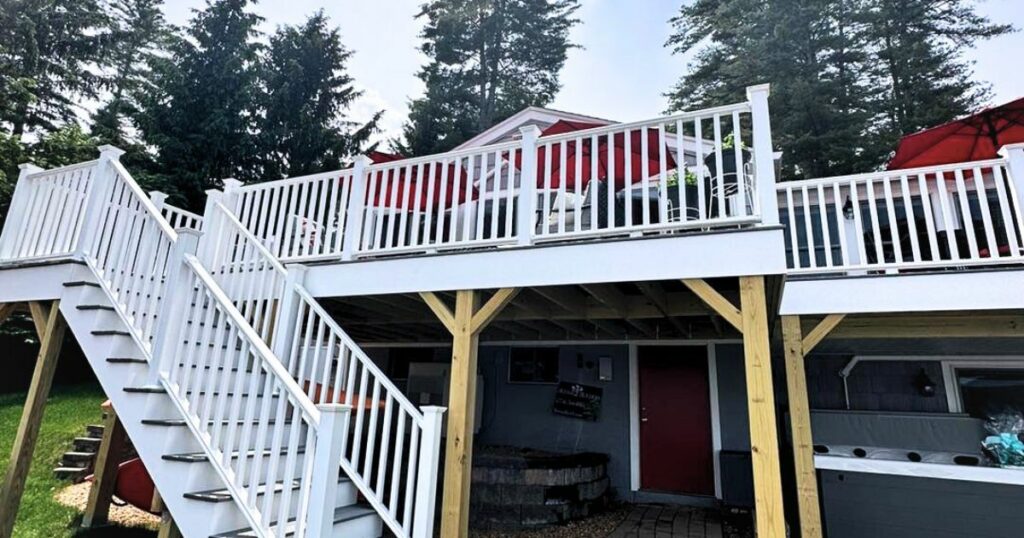
When considering how much to add an addition to a house, understand the various types of additions and their associated costs. Each type of addition varies significantly based on factors like size, materials, and design complexity.
Bedroom Addition
Adding a bedroom can significantly increase the functionality and value of your home. The cost for a bedroom addition can range from $60,000 to $200,000 in areas like Bucks County or Montgomery County, PA. Factors such as the size of the addition, the quality of materials used, and the inclusion of high-end features can affect the overall cost. Design options might include en-suite bathrooms or walk-in closets, which also add to the cost but increase the utility and appeal of the addition.
Bathroom Addition
Bathroom additions require careful consideration of plumbing and electrical setups. Costs can vary widely, typically ranging from $30,000 to $100,000, depending on the complexity and luxury features included. High-end fixtures, luxury tiles, and additional features like underfloor heating can drive up costs. However, the addition of a bathroom generally offers a good return on investment by enhancing the home’s value and functionality. Similarly, adding or remodeling a laundry room can significantly increase a home’s visual appeal, organization, and convenience, making it another valuable addition worth considering.
Kitchen Addition
Expanding or adding a kitchen involves numerous components including cabinetry, appliances, and countertops. Costs can escalate quickly, with total renovation expenses ranging from $50,000 to $250,000. The choice of appliances and cabinetry plays a significant role in the overall cost, with high-end materials and appliances significantly increasing the budget. However, a well-designed kitchen addition can drastically improve the living experience and boost your home’s market value.
Living Room Addition
Adding a living room or expanding an existing one can make your home feel more spacious and accommodating. The cost for a living room addition can range from $60,000 to $400,000, depending on the size and scale of the project. Essential factors include the cost per square foot, which can vary based on materials used and the inclusion of special features like fireplaces or bespoke entertainment units.
Adding a Second Story
Building upward with a second story addition can be a cost-effective way to double your living space without increasing the footprint of your home. This type of addition typically costs between $100 to $200 per square foot, depending on the existing structure’s ability to support additional weight and the complexity of extending utilities to the new level. High-end designs and materials can increase the costs significantly, but the potential ROI makes it an attractive option for many homeowners.
By understanding the specific costs and requirements of each type of home addition, you can make informed decisions that align with your budget and home improvement goals. Each addition type offers different benefits and ROI, which should be carefully weighed before proceeding with construction.
Planning and Financing Your Home Addition
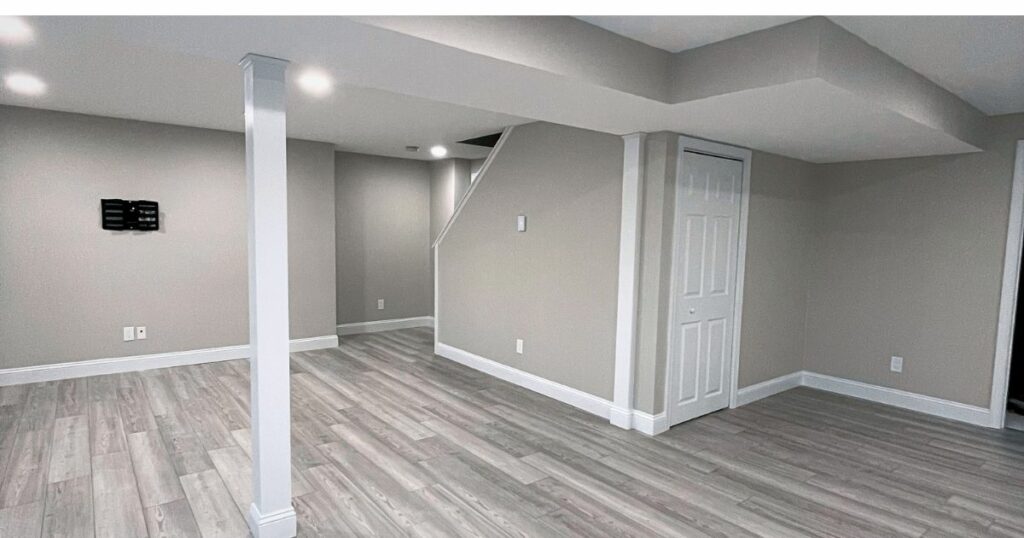
Planning and financing a home addition involves several crucial steps, from understanding zoning laws to selecting the right financing option. It’s important to approach this phase with detailed research and careful consideration to ensure your project is successful and within budget.
Another way to finance your home addition is to borrow money through various means, including taking out a home improvement loan. This type of loan allows homeowners to borrow a lump sum of money using their home as collateral, with the option to make monthly payments over a set period of time. Comparing a home improvement loan to other financing options, such as using savings or a home equity loan, it’s notable that both share similarities like fixed interest rates and repayment periods, but the cost of borrowing money and the impact on your project budget can vary significantly.
Choosing the Right Contractor
Finding the right contractor is perhaps one of the most critical decisions in the home addition process. Your contractor will influence not only the final outcome but also the smooth running of the project and overall expenses.
- Reputation and Experience: Look for contractors with a solid reputation and experience in home additions similar to your project. Bonsai Builders, for instance, is known for translating visions into practical and aesthetically pleasing designs while navigating building codes and zoning regulations.
- References and Past Projects: Always ask for references and review past projects. This step will give you a clearer idea of their capability and the quality of work they can deliver.
- Licenses and Insurance: Ensure the contractor is licensed and insured. This protects you against liability and ensures they meet the regulatory standards.
Financing Options
Financing a home addition can be as complex as the construction itself. There are several financing options available, but choosing the right one depends on your financial situation and the project’s total cost.
- Home Equity Loans: This is a popular choice because it offers fixed interest rates and a lump sum that covers the cost of your project. The interest might be tax-deductible, adding an extra benefit.
- Personal Loans: These are unsecured loans that are based on your credit score. They’re quicker to obtain but usually have higher interest rates than home equity loans.
- Home Equity Line of Credit (HELOC): HELOCs provide a flexible financing option where you can draw funds as needed, making it ideal for projects where costs might vary.
Permits and Zoning Laws
Before breaking ground on your addition, understanding and complying with local zoning laws and obtaining the necessary permits is essential. These regulations can affect everything from the size and placement of your addition to the types of materials you can use.
- Zoning Laws: Check with your local zoning office to understand what you can and cannot do. Zoning laws can influence the height, bulk, and overall size of your addition.
- Permits: Securing the right permits is crucial. Not only is it legally required, but it also ensures that your addition is built to code, which is important for safety and insurance purposes.
Budget Management
Effective budget management can prevent cost overruns and ensure your project stays financially viable.
- Detailed Cost Estimation: Start with a detailed estimate of all costs, including materials, labor, permits, and unexpected contingencies.
- Regular Reviews: Regularly review and adjust the budget as the project progresses to accommodate any unforeseen changes or challenges.
By carefully planning each aspect of your home addition, from choosing the right contractor like Bonsai Builders to securing financing through options like home equity loans or HELOCs, you can ensure a smoother process and a successful completion of your project. Each decision should be made with thorough research and careful consideration, aligning with your overall home improvement goals and financial capabilities.
Maximizing the Value of Your Home Addition
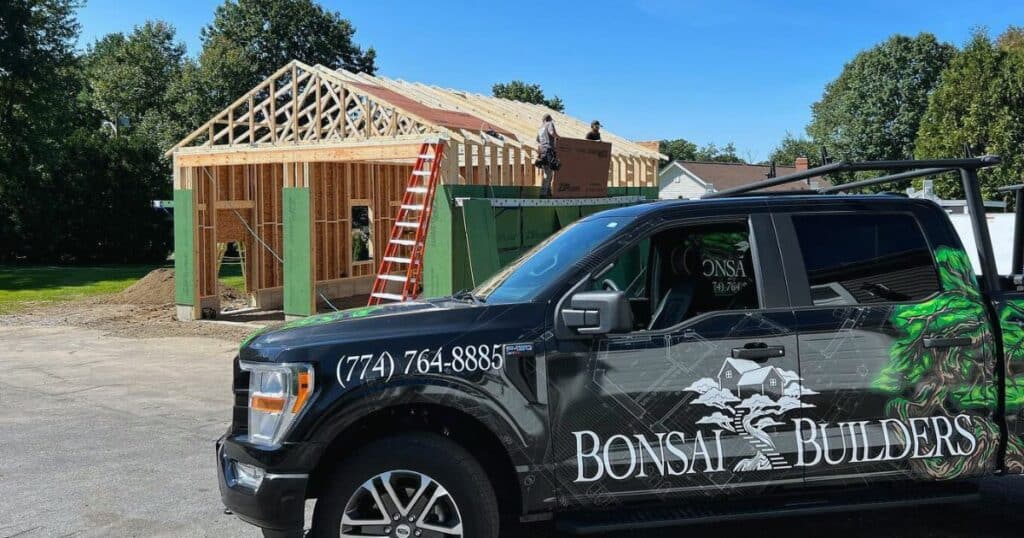
Building Up vs. Building Out
When it comes to how much to add an addition to a house, understanding whether to build up or build out can significantly impact your return on investment (ROI), costs, and the overall functionality of your property.
Cost Comparison
Building up typically involves adding a second story to an existing structure. This can be costly, with prices ranging from $100 to $500 per square foot depending on the complexity and the need for structural reinforcement. However, building out, which extends the home’s footprint on the ground level, often requires additional foundation work, which can also be expensive. The choice between building up or out usually depends on the zoning laws, the property’s layout, and your budget.
Space Utilization
Building up allows you to preserve yard space, which can be crucial in urban areas where outdoor space is limited. On the other hand, building out can spread your living space more evenly and is often less disruptive to the existing living areas during construction. This approach may be more suitable for homes on larger lots where outdoor space is abundant.
Impact on Property
Adding a second story can dramatically change the exterior aesthetics of your home and potentially increase its curb appeal. However, ensure that the addition blends seamlessly with the existing structure to avoid a mismatched appearance. Building out can enhance the home’s footprint, potentially increasing its functional value, especially if it adds desired spaces like a larger kitchen or living area.
ROI and Future Resale Value
According to the National Association of Realtors, adding a bathroom can increase a home’s resale value by more than 50 percent, while master bedroom additions can range from $25,000 to $100,000, depending on the luxury level. It’s crucial to consider the typical ROI in your area and how the addition will appeal to future buyers. For instance, adding a second story might offer a better ROI in neighborhoods with high land values.
Design Tips
When planning your addition, whether up or out, choose designs and materials that complement the existing structures. Consistency in design helps maintain the aesthetic appeal of your home, which is crucial for future resale value. For example, if the original structure has wood siding, continuing this material into the new addition might be more expensive but necessary for visual continuity.
Material Selection
The choice of materials can significantly affect both costs and future maintenance. Using synthetic or prefabricated materials can be a cost-effective and durable option. For instance, vinyl siding costs less than wood but can still offer a visually appealing finish. Always balance cost, durability, and aesthetics when selecting materials for your addition.
By carefully considering these factors, you can maximize both the functional and financial value of your home addition. Building up might be ideal for smaller lots, while building out could better suit larger properties. Each strategy offers unique benefits and challenges, and the right choice depends on your specific property characteristics, family needs, and financial situation. Each decision should be made with thorough research and careful consideration, aligning with your overall home improvement goals and financial capabilities.
Conclusion
Adding an addition to your home is a significant decision that can enhance your living space and increase your property’s value. Whether you’re considering a cozy new bedroom, a modernized kitchen, or even an ambitious second story, understanding the costs and strategic planning involved is crucial. How much to add an addition to a house varies widely based on factors like location, materials, and the complexity of the design.
At Bonsai Builders, we specialize in making these projects as seamless and stress-free as possible. Our team of expert craftsmen is dedicated to creating additions that not only meet your needs but also blend beautifully with your existing home structure. We manage every detail from design to completion, ensuring high-quality results that you and your family will enjoy for years to come.
If you’re ready to expand your living space and enhance your home’s functionality and appeal, we’re here to help. For more detailed information on our services and to discuss your specific project needs, contact Bonsai Builders today. Let us help you make your home addition dream a reality with our expert guidance and master craftsmanship. Your ideal home expansion is just a consultation away!
Frequently Asked Questions about Home Additions
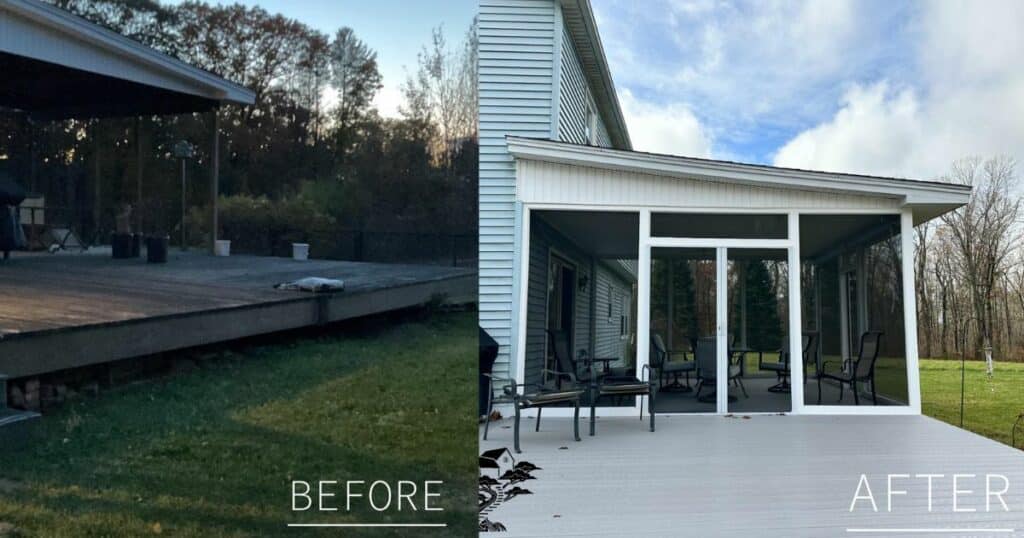
Is it cheaper to add on or build up?
Deciding whether to add on to your home horizontally (building out) or vertically (building up) can significantly impact the cost. Building up is often less expensive as it typically avoids the costly foundation work required for building out. However, it may require strengthening the existing foundation and modifying the roof, which can add to the cost.
For instance, building up by adding a second story to an existing structure usually means no additional land is used, and major ground-level structural changes can be avoided. However, the need for additional structural support and potentially complex modifications to the existing building can increase costs.
Conversely, building out involves extending the home’s footprint, which might require extensive excavation, foundation, and roofing work. This option consumes more land and can also involve significant costs related to landscape alterations and extended utility lines.
What is the cheapest home addition?
The most budget-friendly home addition is typically one that involves minimal structural changes and uses existing utilities. Adding a simple room on the ground floor, or converting existing space like garages or basements into living areas, often costs less than complex additions like kitchens or bathrooms, which require extensive plumbing and electrical work.
A basic room addition for uses such as a home office or spare bedroom, where major plumbing isn’t required, can be a cost-effective choice. This type of addition generally involves only basic construction materials and minimal alterations to the existing structure and utilities.
What type of addition adds the most value to a home?
The type of addition that adds the most value to a home generally includes adding usable, appealing space that is highly sought after in the housing market. Kitchen expansions and bathroom additions are typically at the top due to their high demand among homebuyers.
- Kitchen Additions: Expanding or modernizing a kitchen with high-quality materials and modern appliances can offer a substantial return on investment by making the home more attractive to potential buyers.
- Adding Bedrooms and Bathrooms: Additional bedrooms and bathrooms are highly prized by homebuyers, particularly in family-oriented neighborhoods. These additions can make a home suitable for a broader range of buyers and significantly increase its market value.
- Master Suites: Adding a master suite, which includes a spacious bedroom, attached bathroom, and ample closet space, can significantly boost a home’s appeal and resale value.
Each addition type has the potential to enhance your home’s marketability and functionality, but the best choice depends on the current market trends, the specific needs of your neighborhood, and your personal circumstances. Consulting with real estate professionals and contractors like Bonsai Builders can provide tailored advice to ensure your addition maximizes both your home’s value and your personal enjoyment.
Our Content
Our experienced contractors and design specialists carefully review and edit all content to ensure it meets our high standards for quality and accuracy. We do this to provide our readers with content that is accurate, complete, reliable, and up-to-date. Bonsai Builders, located in Sutton, Massachusetts is a trusted neighborhood building source across Massachusetts for kitchen remodeling, construction process of brand new houses, and more with over 26 years of experience and over 125 jobs completed.
Bonsai Builders has renovated many split-level home kitchens across Massachusetts. Bonsai Builders is selected as best of Houzz year after year further showing their expertise and trust among homeowners in Massachusetts.
